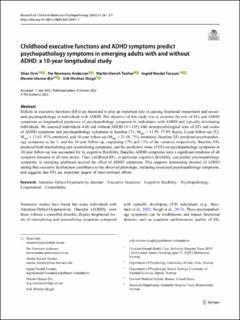| dc.contributor.author | Orm, Stian | |
| dc.contributor.author | Andersen, Per Normann | |
| dc.contributor.author | Teicher, Martin H. | |
| dc.contributor.author | Fossum, Ingrid Nesdal | |
| dc.contributor.author | Øie, Merete Glenne | |
| dc.contributor.author | Skogli, Erik Winther | |
| dc.date.accessioned | 2023-08-03T12:30:50Z | |
| dc.date.available | 2023-08-03T12:30:50Z | |
| dc.date.created | 2022-07-05T17:55:37Z | |
| dc.date.issued | 2022 | |
| dc.identifier.citation | Research on Child and Adolescent Psychopathology. 2023, 51, 261–271 . | en_US |
| dc.identifier.issn | 2730-7166 | |
| dc.identifier.uri | https://hdl.handle.net/11250/3082503 | |
| dc.description | © The Author(s) 2022. This article is licensed under a Creative Commons Attribution 4.0 International License. | en_US |
| dc.description.abstract | Deficits in executive functions (EFs) are theorized to play an important role in causing functional impairment and associated psychopathology in individuals with ADHD. The objective of this study was to examine the role of EFs and ADHD symptoms as longitudinal predictors of psychopathology symptoms in individuals with ADHD and typically developing individuals. We assessed individuals with and without ADHD (N = 135) with neuropsychological tests of EFs and scales of ADHD symptoms and psychopathology symptoms at baseline (T1; Mage = 11.59, 57.8% boys), 2-year follow-up (T2; Mage = 13.63, 97% retention), and 10-year follow-up (Mage = 21.18, 75% retention). Baseline EFs predicted psychopathology symptoms at the 2- and the 10-year follow-up, explaining 17% and 12% of the variance, respectively. Baseline EFs predicted both internalizing and externalizing symptoms, and the predictive value of EFs on psychopathology symptoms at 10-year follow-up was accounted for by cognitive flexibility. Baseline ADHD symptoms were a significant predictor of all symptom domains at all time points. Thus, childhood EFs, in particular cognitive flexibility, can predict psychopathology symptoms in emerging adulthood beyond the effect of ADHD symptoms. This supports dominating theories of ADHD stating that executive dysfunction contributes to the observed phenotype, including associated psychopathology symptoms, and suggests that EFs are important targets of interventional efforts. | en_US |
| dc.language.iso | eng | en_US |
| dc.relation.uri | https://link.springer.com/content/pdf/10.1007/s10802-022-00957-7.pdf | |
| dc.rights | Navngivelse 4.0 Internasjonal | * |
| dc.rights.uri | http://creativecommons.org/licenses/by/4.0/deed.no | * |
| dc.subject | Attention-Deficit/Hyperactivity disorder | en_US |
| dc.subject | executive functions | en_US |
| dc.subject | cognitive flexibility | en_US |
| dc.subject | psychopathology | en_US |
| dc.subject | longitudinal | en_US |
| dc.subject | comorbidity | en_US |
| dc.title | Childhood executive functions and ADHD symptoms predict psychopathology symptoms in emerging adults with and without ADHD: A 10-year longitudinal study | en_US |
| dc.type | Peer reviewed | en_US |
| dc.type | Journal article | en_US |
| dc.description.version | publishedVersion | en_US |
| dc.subject.nsi | VDP::Samfunnsvitenskap: 200::Psykologi: 260 | en_US |
| dc.source.pagenumber | 261–271 | en_US |
| dc.source.volume | 51 | en_US |
| dc.source.journal | Research on Child and Adolescent Psychopathology | en_US |
| dc.identifier.doi | 10.1007/s10802-022-00957-7 | |
| dc.identifier.cristin | 2037267 | |
| dc.relation.project | Oslo universitetssykehus HF: 150616 | en_US |
| dc.relation.project | Sykehuset Innlandet HF: 150624 | en_US |
| dc.relation.project | Sykehuset Innlandet HF: 150648 | en_US |
| dc.relation.project | Sykehuset Innlandet HF: 150610 | en_US |
| cristin.ispublished | true | |
| cristin.fulltext | original | |
| cristin.qualitycode | 2 | |

